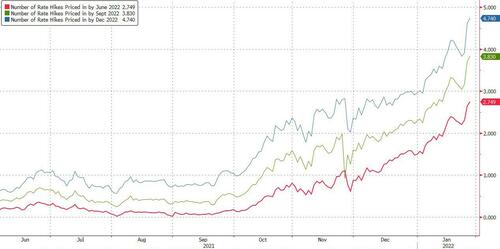S&P 500 Sweet Spot Could Be Around 3,900 To 4,130
By Ven Ram, Bloomberg Markets Live cross-asset strategist.
The S&P 500 Index will find its equilibrium band for 2022 between 3,900 and 4,130.
That’s according to an analysis that parses the benchmark as lesser-rated quasi-debt securities. The study is based on the premise that the aggregate earnings per share of the S&P 500 companies will be about $225 to $240 this year (hence the forecast band for the index rather than a single-point estimate) and that current forward rates correctly anticipate the Fed’s policy trajectory over 2022.
It assumes that stocks trade with risk premiums over default-free securities to allow for their higher variance of returns. In other words, investors can price these securities by factoring in a spread to the default-free curve, akin to the concept of a Z-spread.
The analysis doesn’t imply that stocks have found a bottom — far from it. Rather, the assumption is that — after probably yo-yoing above and below posited levels — stocks will find equilibrium at those levels this year. More specifically, they may oscillate closely around the central value this year.
The study suggests that the decline we saw earlier this week to 4,222 was far from coincidental.
The slump is a consequence of the markets finally paying heed to the writing on the wall vis-a-vis the Fed’s benchmark rate, and its implications for the Treasury curve. If 2020 was marked by an acute need for pension funds and portfolio managers to go long stocks in a desperate search for yield, last year proved to be no different given the Fed’s uber-accommodative stance.
Last year, the risk premium on the S&P 500 over the 10-year Treasury yield shrank to the lowest since 2007, leaving the index vulnerable to a major shift in risk appetite. That came after the market capitalization of the Wilshire 5000 Index amounted to 190% of then-U.S. gross domestic product, eclipsing valuations that prevailed even during the dotcom bubble.
How well could this analysis fare? Just in December, a study showed that the base case for the Nasdaq 100 basket of stocks was far lower than prevailed then based on earnings estimates. If anything, the index has slumped more and sooner than I expected. (Current earnings predictions suggest the technology barometer may slide to around 13,450 this year).
The analysis is dynamic, which is to say it’s extremely sensitive to changes in earnings and interest rates, meaning the posited central level will change in line with forecasts on both. The more drastic the changes in the projected earnings and interest rates, the greater will be the variance from the central level.
At the moment, overnight indexed swaps are factoring in about 100 basis points of increase in the Fed funds rate. If threats from variants upend the forecast economic recovery, that pricing may not fructify, throwing a wrench in the forecast for the index. In such an adverse scenario, stocks may stay supported at levels higher than posited.
On the other hand, if the Fed were to raise rates more than four times and also shrink its humongous balance sheet, stocks will find themselves plumbing lower.
Tyler Durden
Thu, 01/27/2022 – 12:05
via ZeroHedge News https://ift.tt/3o7dTOL Tyler Durden
